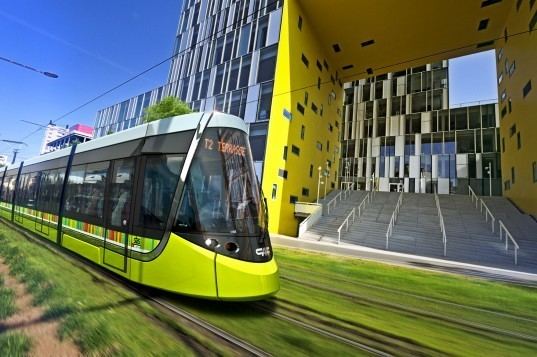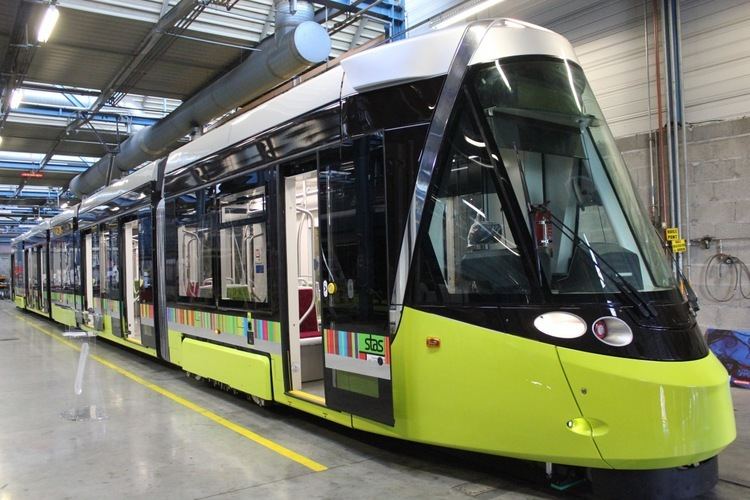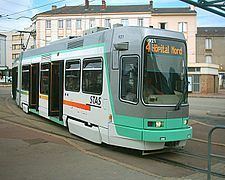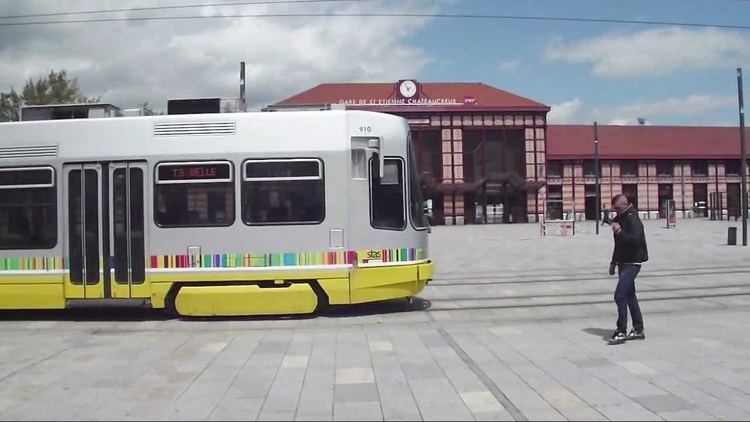Daily ridership 92,000 (2012) Number of stations 37 | System length 11.7 km (7.3 mi) Began operation December 4, 1881 Number of lines 2 | |
 | ||
Track gauge 1,000 mm (3 ft 3 ⁄8 in) metre gauge Operator Société de Transports de l'Agglomération Stéphanoise | ||
The Saint-Étienne tramway (French: Tramway de Saint-Étienne) is a tram system in the city of Saint-Étienne in the Rhône-Alpes (France) that has functioned continuously since its opening in 1881. The first tramway line was steam-operated and was opened by the Chemins de Fer à Voie étroite de Saint-Étienne (CFVE) on 4 December 1881, stretching for 5.5 km between La Terrasse and Bellevue. The CFVE took over the Compagnie des Tramways Électriques de Saint-Étienne lines and discontinued the use of steam in 1912.
Contents
- Network
- Tram carhouses
- Rolling stock
- Type A tramcars
- Type H tramcars
- Type R tramcars
- PCC tramcars
- Alsthom Vevey Duewag articulated tramcars
- CAF Urbos
- Saint tienne trams in preservation
- References

Lines with small patronage were replaced by trolleybuses in 1932 with all but one line closed in 1956 as a result of the impossibility of running these buses on the busiest line of the network. The decision to keep the tramway in the 1950s saw the introduction of the famous PCC tramcars to replace 1932 rolling stock and the Vevey-Alsthom tramcars in 1991-1992. The system is operated by the STAS.

Network

The Saint-Étienne tramway now runs from Hôpital Nord to Solaure after an extension of the original line from Bellevue station to Solaure in 1983 and from La Terrasse station to Hôpital Nord in 1991, with a length of 9.3 km. The old terminals are now where some trams turn back during peak hours and others continue to Solaure and Hôpital Nord.

A line from Cinq-Chemins de Terre Noire to Saint-Jean-Bonnefonds opened in 1907 and closed on 1 April 1932 after being replaced by a bus service. Lines from the town centre to Le Pertuiset, Saint-Genest-Lerpt and Roche-la-Molière opened between 1907 and 1909. A second line to supplement the main route opened in 2006 to serve the Chateaucreux station.
Trolleybuses were put into service on 1 January 1942 between Raspail and Place Dorian.
Tram carhouses
The current and only carhouse is on the Transpôle site near Saint-Étienne's northern hospital; until 1998 it was at Bellevue. The carhouse as well as the PCC streetcars were demolished.
The new carhouse was built south of Hôpital Nord and north of Terrasse. It is the STAS depot for Saint-Étienne and houses buses, trolleybuses and trams.
Rolling stock
Saint-Étienne tramway currently runs a fleet of 35 tramcars. There have been four large fleets of tramcars to operate on the network, the largest being the fleet of PCC cars introduced in 1958. 2016 brings the fifth generation of trams with Urbos lowfloor trams.
Type A tramcars
Type A tramcars were built by Grammont in 1897. The 28 cars circulated from 1897 to 1952, were 7.50 m long, 2 m wide and were capable of transporting 40 passengers.
Type H tramcars
The Type H tramcars were introduced in 1907 at the start of the electric traction services. The cars were 10.21 m in length, 2 m wide, weighed 12.3 t (empty) and developed 100 hp (2 x 5t) hp. They were operated by a wattman and a receiver (ticket collector) and could carry 48 passengers. The cars lay on a Brill 79 Ex2 truck.
Type R tramcars
Type R tramcars were built by the CGC of Saint-Denis in 1912. All eight of the cars circulated from 1912 to 1959 and were capable of carrying 47 passengers. The tramcars weighed 13 tonnes empty and were 9.35 m long and 2 m wide.
PCC tramcars
The PCC streetcar fleet was composed of 30 single-car trams built in Strasbourg which were introduced in 1958 after the decision to keep the busiest tramway line was made, with the last one withdrawn in 1998.
Alsthom-Vevey-Duewag articulated tramcars
This class of tramcars, a variation of the Tramway Français Standard, exists in two types, tramcars introduced in 1991 and those in 1998. The first class was introduced between 1991 and 1992 at the time of the line extension to Hôpital Nord. They are numbered 901 to 915 and have a seating capacity of 43. In 1998, more tramcars were introduced with only minor differences, numbered 916 to 935.
The first class of modern tramcars (15) was equipped with trolley poles since the PCC trams were still in use. These were subsequently replaced by pantographs as the PCC trams were withdrawn and the second group of modern cars was introduced.
The second class of Alsthom-Vevey tramcars (20) are capable of reaching a maximum speed of 70 km/h. They were built on 23.24 m long H chassis and have an empty weight of 27.4 tonnes. The electric current is conveyed by pantograph rather than the trolley poles used on the PCC trams. The current delivered is 600V DC.
CAF Urbos
In order to replace and expand the fleet, in 2014 a €42m contract was signed with CAF for delivery of 16 Urbos trams, scheduled for delivery in the spring of 2016.
These trams have 100% low floor with a total length of 33 metres in 5 modules. The trams are bi-directional with doors on both sides.
Saint-Étienne trams in preservation
Société de Transports de l'Agglomération Stéphanoise still has 6 PCC streetcars:
